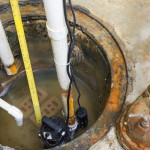Ensure Sump Pumps Are Ready for Spring
Spring and the rainy season can pose an increased risk of flooding and water damage, so it’s crucial to ensure sump pumps are working well and ready to protect the home. This blog post will discuss how sump pumps work and how to keep them ready for when they will be needed.
How Do Sump Pumps Work?
 A sump pump installation is a home's primary defense system against flooding and its consequences, such as expensive water damage and mold, during snow thaws, storms, heavy rainfall, and other situations that can cause flooding. Sump pumps are located in a specially designed sump pit or basin at the lowest point of the house or basement, where groundwater naturally accumulates. Once water reaches a predetermined level in the pit, the float switch activates the sump pump to turn on.
A sump pump installation is a home's primary defense system against flooding and its consequences, such as expensive water damage and mold, during snow thaws, storms, heavy rainfall, and other situations that can cause flooding. Sump pumps are located in a specially designed sump pit or basin at the lowest point of the house or basement, where groundwater naturally accumulates. Once water reaches a predetermined level in the pit, the float switch activates the sump pump to turn on.
The sump pump turns on automatically when the water level reaches a certain point in the basin, so intervention from a homeowner is not needed, ensuring it can protect the home whether people are home or not. Once activated, the pump's impeller creates centrifugal force that pushes water toward the discharge pipe. From there, the water travels through the pipe and safely away from the home and its foundation.
Two common types of primary sump pumps are a submersible sump pump and a pedestal sump pump. With submersible sump pumps, the motor is located in the pit and can operate underwater. This helps them operate more quietly than pedestal sump pumps. Submersible sump pumps are also more powerful. On the other hand, the motor of pedestal sump pumps sits above the pit and doesn’t get submerged, which allows for easier access during maintenance and repairs. They are more affordable than a submersible sump pump, but they’re less powerful.
How to Make Sure a Sump Pump Works Correctly
 Regular sump pump testing and maintenance are important ways to ensure it continues to operate correctly and is ready to protect the home and basement from flooding when needed. To test and verify whether a sump pump is working correctly, pour a few gallons of water into the sump pit until the float switch rises enough to trigger the pump. Then watch the water level decrease as it travels through the discharge pipe away from the house. Any issues with water removal or automatic activation indicate problems and the need for sump pump repair.
Regular sump pump testing and maintenance are important ways to ensure it continues to operate correctly and is ready to protect the home and basement from flooding when needed. To test and verify whether a sump pump is working correctly, pour a few gallons of water into the sump pit until the float switch rises enough to trigger the pump. Then watch the water level decrease as it travels through the discharge pipe away from the house. Any issues with water removal or automatic activation indicate problems and the need for sump pump repair.
Annual sump pump maintenance by a professional is also recommended to keep a sump pump working and prepared for use. Plumbers can inspect the sump pump system and catch problems homeowners may miss, allowing for issues to be addressed before they cause sump pump failure.
Why a Sump Pump Backup Is Important
Excessive water and flooding may overwhelm the primary sump pump, leaving the home or basement vulnerable to flooding and costly water damage. Installing a backup sump pump system provides additional protection when the main pump can't keep up with heavy water infiltration. Additionally, when a sump pump malfunctions and fails or loses power during a power outage, it won’t be able to protect the home properly. However, when a home has a sump pump backup, the backup sump pump will be able to take over, preventing flooding. It’s crucial to note that power outages can coincide with storms and weather events that cause flooding, so a backup is needed for consistent flood protection, even during an outage.
Some popular sump pump backup options include a battery-operated backup sump pump, which is the most popular choice for homeowners, and a water-powered sump pump backup that utilizes water pressure to power the sump pump and can run as long as the house has a working water supply.
About Jim Wagner Plumbing, Inc.
Jim Wagner Plumbing, Inc. is a family-owned and operated company serving the Lombard community. They provide flat-rate pricing, on-time service, and honest advice and recommendations. Call them for sump pump services in Lombard, IL.



